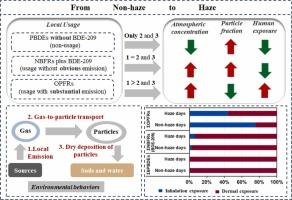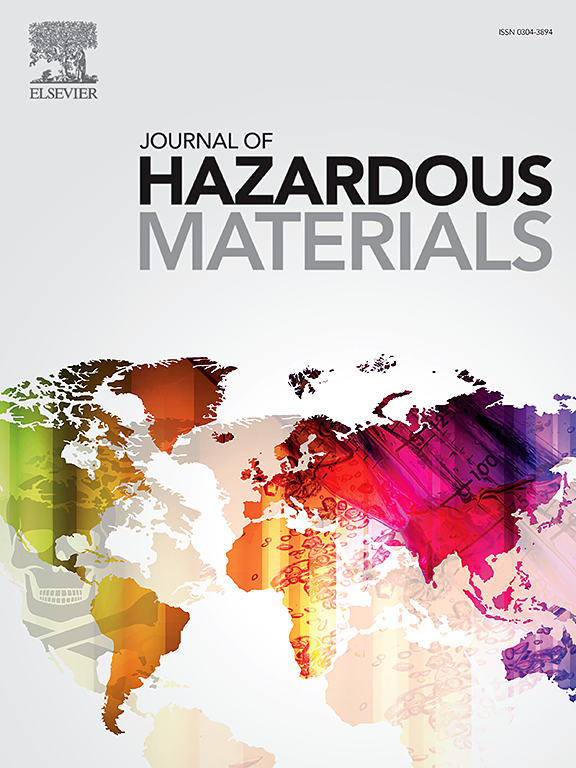雾霾对不同用途的空气中阻燃剂相分布和人体暴露的影响机制:排放、隔断和干沉积
IF 12.2
1区 环境科学与生态学
Q1 ENGINEERING, ENVIRONMENTAL
引用次数: 0
摘要
本研究阐明了在雾霾天不同用途阻燃剂(FRs)的发生和人体暴露变化的机制。雾霾天气的高大气稳定性将大气环境转化为一个封闭的系统,其中局部排放(LM)、气粒输运(GPT)和颗粒干沉降(DP)决定了fr的命运和目的地。GPT和DP, FRs被DP去除,从而减少了人类的暴露。相反,当LM≈GPT和DP时,雾霾日空气颗粒物的增加仅影响FRs的发生和人体暴露,其气粒分配商(log KP)在-3.95 ~ -1.45之间。我们还分析了在中国一个经常发生雾霾的城市的非雾霾日和雾霾日收集的198个大小分离颗粒样本和22个气体样本中的三种类型的FRs。本研究验证了上述机制,并从根本上解释了其他已发表的研究中雾霾天擦肤样品中多溴联苯醚(PBDEs)水平下降的原因。这些结果表明,雾霾对人体暴露于FRs有多种影响,为全面了解雾霾对健康的影响提供了新的基础。本文章由计算机程序翻译,如有差异,请以英文原文为准。

Mechanisms of haze influencing phase distribution and human exposure to airborne flame retardants with different uses: Emission, partition, and dry deposition
This study elucidated the mechanisms governing variations in the occurrence and human exposure to flame retardants (FRs) with diverse applications on haze days. The high atmospheric stability on haze days converts the atmospheric environment into a closed system, where local emissions (LM), gas-to-particle transport (GPT), and dry deposition of particles (DP) determine the fate and destination of FRs. When LM < GPT and DP, FRs are removed by DP, thereby decreasing human exposure. Conversely, when LM ≈ GPT and DP, the increase in airborne particles on haze days only affects occurrences and human exposure to FRs with gas-particle partitioning quotient (log KP) ranging from −3.95 to −1.45. We also analysed three types of FRs in 198 size-segregated particulate samples and 22 gaseous samples collected on non-haze and haze days in a Chinese city where haze frequently occurs. This study validated the aforementioned mechanisms and fundamentally accounted for the decreased levels of polybrominated diphenyl ethers (PBDEs) in skin-wipe samples on haze days in other published studies. These results suggest that haze has diverse influences on human exposure to FRs and provide a new basis for a comprehensive understanding of the health effects of haze.
求助全文
通过发布文献求助,成功后即可免费获取论文全文。
去求助
来源期刊

Journal of Hazardous Materials
工程技术-工程:环境
CiteScore
25.40
自引率
5.90%
发文量
3059
审稿时长
58 days
期刊介绍:
The Journal of Hazardous Materials serves as a global platform for promoting cutting-edge research in the field of Environmental Science and Engineering. Our publication features a wide range of articles, including full-length research papers, review articles, and perspectives, with the aim of enhancing our understanding of the dangers and risks associated with various materials concerning public health and the environment. It is important to note that the term "environmental contaminants" refers specifically to substances that pose hazardous effects through contamination, while excluding those that do not have such impacts on the environment or human health. Moreover, we emphasize the distinction between wastes and hazardous materials in order to provide further clarity on the scope of the journal. We have a keen interest in exploring specific compounds and microbial agents that have adverse effects on the environment.
 求助内容:
求助内容: 应助结果提醒方式:
应助结果提醒方式:


